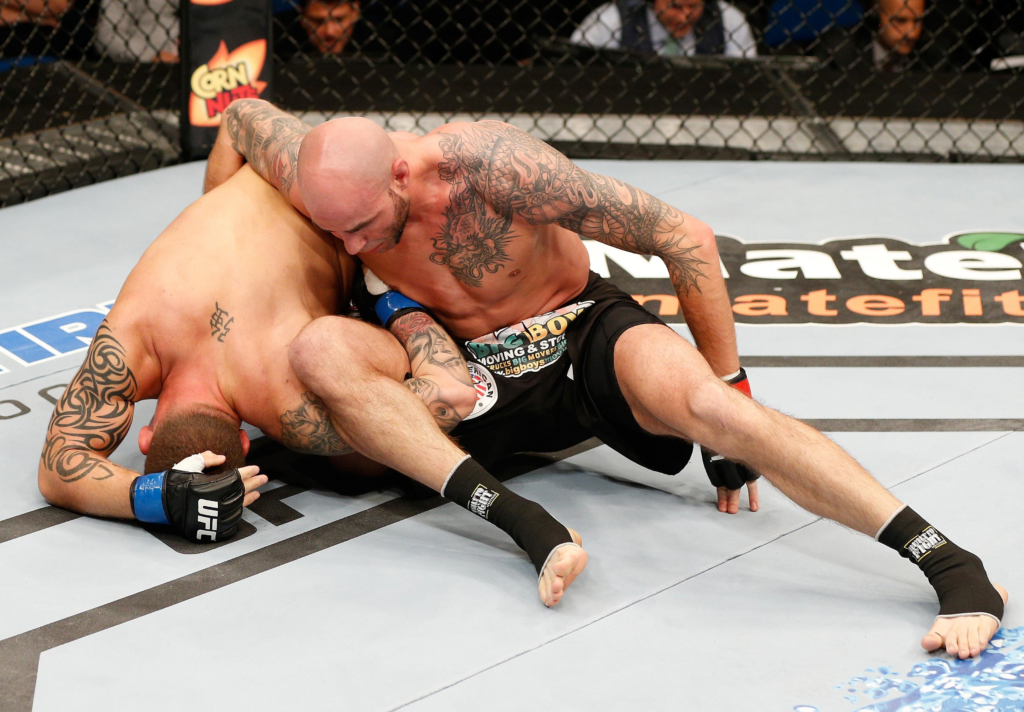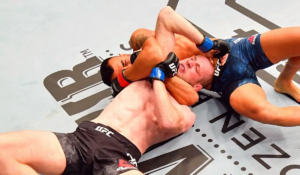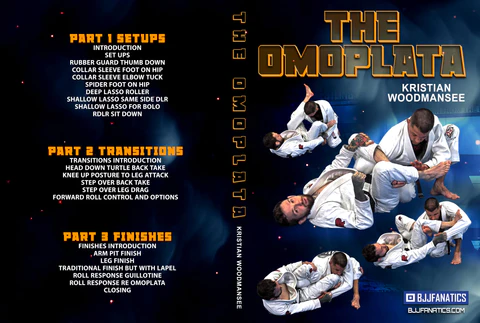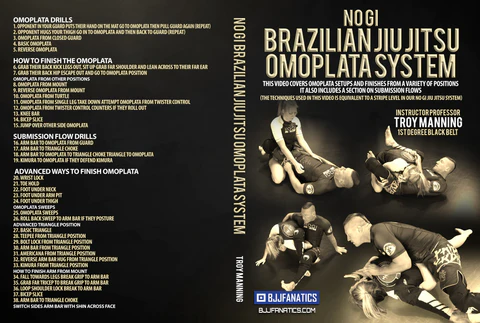The omoplata is a shoulder lock that can be used to submit your opponent or sweep them onto their back. The Omoplata is a versatile and effective technique that can be used from a variety of positions, including guard, half-guard, and mount.
To execute the Omoplata, you first need to isolate your opponent’s arm and bring your leg over their shoulder. From there, you use your legs to control their body and apply pressure to their shoulder joint. If done correctly, the Omoplata can be a very effective submission, forcing your opponent to tap out or risk injury. However, it’s important to note that the Omoplata is not a guaranteed submission, and your opponent may be able to escape if they have a good defense.
What is the Omoplata Submission?

The Omoplata is a shoulder lock submission in Brazilian Jiu-Jitsu that can be highly effective when executed correctly. It involves trapping your opponent’s arm and using your hips as leverage to apply pressure to their shoulder joint. The submission can be performed from a variety of positions, such as Closed Guard, Rubber Guard, or even from the top position.
To execute the Omoplata submission, you need to isolate your opponent’s arm and turn until you’re parallel with them. You then hyperextend their arm and shoulder by using your hips to apply pressure. The submission can also be used as a sweep to gain a dominant position.
The mechanics of the Omoplata involve applying pressure to the shoulder joint by using your hips as a lever. The pressure is applied to the shoulder blade and the armpit, which can cause pain or even injury if not defended properly. The submission can also be used to set up other submissions, such as the Kimura or Triangle Choke.
To defend against the Omoplata, you need to be aware of the setup and avoid getting your arm trapped. You can also use your other arm to push against your opponent’s leg to prevent them from applying pressure with their hips. If you do get trapped in the submission, you can try to roll out of it or use your free arm to relieve the pressure.
How to Perform the Omoplata Submission

In this section, we’ll break down the steps you need to take to perform this technique effectively.
Step 1: Setup
To set up the Omoplata submission, you’ll need to start from a closed guard position. From here, you’ll need to isolate one of your opponent’s arms and trap it between your legs. You can do this by using your hips to create space and then wrapping your legs around your opponent’s arm, locking it in place.
Step 2: Transition to the Omoplata Position
Once you’ve isolated your opponent’s arm, you’ll need to transition to the Omoplata position. To do this, you’ll use your free leg to push off of your opponent’s hip and create space. From here, you’ll swing your trapped leg over your opponent’s shoulder and roll onto your back, ending up in a seated position with your opponent’s arm trapped between your legs.
Step 3: Control and Apply Pressure
With your opponent’s arm trapped between your legs, you’ll need to control their posture and apply pressure to their shoulder to set up the submission. To do this, you can use your hands to grab onto your opponent’s pants or the back of their gi, pulling them towards you and controlling their posture. You can also use your hips to apply pressure to your opponent’s shoulder, making it difficult for them to escape.
Step 4: Finish the Submission
To finish the Omoplata submission, you’ll need to apply pressure to your opponent’s shoulder and use your legs to create a lever that puts pressure on their arm. You’ll need to lift your hips and use your legs to push down on your opponent’s shoulder, creating a shoulder lock that will force them to tap out.
Common Mistakes to Avoid
When it comes to the Omoplata submission, there are several common mistakes that you should avoid to increase your success rate. Here are some of the most important ones:
1. Not Controlling the Opponent’s Posture
One of the most common mistakes when attempting the Omoplata is not properly controlling the opponent’s posture. If your opponent can sit up or posture up, it will be much harder for you to finish the submission. To prevent this, make sure to control your opponent’s posture by keeping your legs tight around their shoulder and neck area.
2. Not Setting Up the Submission Properly
Another common mistake is not setting up the Omoplata submission properly. You need to isolate your opponent’s arm and turn your body until you are parallel with them. If you don’t do this correctly, your opponent will be able to defend the submission more easily.
3. Not Applying Enough Pressure
To finish the omoplata submission, you need to apply enough pressure to your opponent’s shoulder. If you don’t apply enough pressure, your opponent will be able to escape the submission. Make sure to use your legs to apply pressure and keep your opponent’s arm locked in place.
4. Not Following Through with the Submission
Another common mistake is not following through with the submission. If you release the submission too early, your opponent will be able to escape. Make sure to finish the submission completely and hold it until your opponent taps out.
5. Focusing Only on the Submission
Finally, one of the most common mistakes is focusing only on the Omoplata submission and not considering other options. If you can’t finish the submission, you can use the position to sweep your opponent or transition to another submission. Keep your options open and be ready to adapt to your opponent’s movements.
By avoiding these common mistakes, you can increase your success rate with the Omoplata submission and become a more effective grappler.
Omoplata Submission Variations
When it comes to the Omoplata submission, there are several variations that you can use to trap your opponent and force them to submit. This section will discuss the Kimura Grip Omoplata and the Triangle Omoplata.
Kimura Grip Omoplata
The Kimura Grip Omoplata is a variation of the Omoplata that utilizes the Kimura grip to secure the opponent’s arm. To execute this technique, you will first need to isolate your opponent’s arm and secure it in the Kimura grip. From there, you will need to pivot your hips and use your leg to trap your opponent’s arm. Apply pressure to the shoulder and hip to force your opponent to submit.
Triangle Omoplata
The Triangle Omoplata is another variation of the Omoplata that utilizes the triangle choke to secure the opponent. To execute this technique, you will first need to isolate your opponent’s arm and trap it with your leg. From there, you will need to pivot your hips and use your other leg to secure a triangle choke. Apply pressure to the shoulder and wrist to force your opponent to submit.
Both the Kimura Grip Omoplata and the Triangle Omoplata are highly effective techniques that can be used to submit your opponent. By using these variations, you can add another layer of complexity to your Brazilian Jiu-Jitsu game and keep your opponent guessing.
It’s important to note that the mechanics of the Omoplata submission can vary depending on the position and setup. For example, the rubber guard can trap the arm and set up the Omoplata, while the lever and coil lock can apply additional pressure to the shoulder and armpit.
When executing the Omoplata submission, being aware of your opponent’s defense is important. If your opponent is able to free their trapped arm, they may be able to escape the submission. To prevent this, make sure to apply pressure to the shoulder and hip to keep your opponent trapped.
By utilizing variations such as the Kimura Grip Omoplata and the Triangle Omoplata, you can add another layer of complexity to your game and keep your opponent guessing.
Tips for Effective Omoplata Submission
To execute an effective Omoplata submission in Brazilian Jiu-Jitsu, you need to have proper technique, timing, and pressure. Here are some tips that can help you improve your Omoplata submission game:
- Isolate the arm: To set up the Omoplata submission, you need to isolate your opponent’s arm. You can do this by trapping their arm between your legs or using your wrist to control their arm. Once you have isolated their arm, you can start applying pressure to their shoulder and hip.
- Use your leg as a lever: The Omoplata submission is a shoulder lock that uses your leg as a lever to apply pressure to your opponent’s shoulder. To make the submission effective, you need to use your leg to create a strong lever that can apply enough pressure to your opponent’s shoulder to force them to tap.
- Apply pressure to the scapula: To make the Omoplata submission effective, you need to apply pressure to your opponent’s scapula. This will help to immobilize their arm and make it difficult for them to escape. To apply pressure to the scapula, you need to use your hip and leg to create a strong downward force.
- Use the rubber guard: The rubber guard is a technique that can help you to trap your opponent’s arm and set up the Omoplata submission. To use the rubber guard, you need to wrap your leg around your opponent’s back and use your foot to trap their arm. This will give you better control over their arm and make setting up the Omoplata submission easier.
- Be patient: The Omoplata submission is not a quick submission. It requires patience and proper technique to execute. You need to apply pressure slowly and steadily to your opponent’s shoulder and hip to make the submission effective.
By following these tips, you can improve your Omoplata submission game and make it a more effective technique in your arsenal. Remember to practice these techniques regularly to master the mechanics of the submission and to be able to apply it in real-life situations.
Training and Practice for the Omoplata
To become proficient in the omoplata submission, you need to train and practice regularly. This joint lock targets the shoulder and shoulder blade, commonly known as the scapula. Here are some tips to help you improve your technique and apply effective pressure:
- Practice with a partner: The more you practice the omoplata submission with a partner, the better you will become. You can start with basic setups and gradually progress to more advanced techniques.
- Focus on mechanics: To execute the omoplata submission effectively, you need to understand the mechanics involved. You should focus on leveraging your hip and leg to apply pressure to your opponent’s shoulder and arm.
- Use the rubber guard: The rubber guard is an effective setup for the omoplata submission. It involves trapping your opponent’s arm with your leg and using your other leg to coil lock their shoulder.
- Isolate your opponent’s arm: To apply the omoplata submission, you need to isolate your opponent’s arm. You can do this by pulling their arm across your body and trapping it with your leg.
- Apply pressure to the shoulder blade: The omoplata submission involves applying pressure to your opponent’s shoulder blade. You can do this by using your hip and leg to lever their arm and shoulder.
- Defend against counterattacks: Your opponent may try to escape the omoplata submission by rolling or stacking you. You should be prepared to defend against these counterattacks by adjusting your position and maintaining control of their arm.
In addition to the omoplata submission, you can also incorporate other techniques such as the kimura, triangle choke, and wrist lock into your training and practice routine. You can become a more well-rounded Brazilian Jiu-Jitsu practitioner by mastering these techniques.
Notable UFC fighters who have attempted the Omoplata Submission
Here are some notable UFC fighters who have attempted the Omoplata submission:
- Ben Saunders pulled off the first Omoplata in UFC history against Chris Heatherly at UFC Fight Night: Henderson vs. Dos Anjos in August 2014.
- Adam Wieczorek shocked Rener Gracie and Brian Ortega with an Omoplata submission victory over Arjan Bhullar on the UFC on Fox 29 card.
- Clark Gracie is known for his effortless-looking Omoplatas and has finished some high-level opponents with the submission.
- Dominyka Obeleyente is known for her Omoplata submission and has achieved open class and weight female black belt world champion titles.
- Louis Glismann scored an inverted Omoplata submission in Oktagon 43, which is considered a candidate for Submission of the Year.
While the Omoplata submission is highly effective in Brazilian Jiu-Jitsu, it is not commonly used in MMA fights due to the difficulty of setting it up and the risk of getting ground and pounded.
Conclusion
Congratulations! You have learned about the Omoplata submission, a powerful technique that can be used to defeat your opponents in Brazilian Jiu-Jitsu and other martial arts. With the right setup and execution, you can use the Omoplata to lock your opponent’s shoulder joint and force them to submit or give up a dominant position.
Remember that the Omoplata is just one of many techniques in your arsenal, and it may not work in every situation. You will need to develop your skills and adapt to different opponents and scenarios to become a successful martial artist. However, the Omoplata is a versatile and effective submission that can be used in a variety of situations, so it’s definitely worth adding to your repertoire.
As you practice the Omoplata, keep in mind the key principles of leverage, timing, and control. You will need to use your legs, hips, and arms to apply pressure to your opponent’s shoulder joint while maintaining control of their body. You will also need to be patient and wait for the right moment to execute the technique, as your opponent may try to defend or counter your attack.
In addition to the basic Omoplata, there are many variations and setups that you can use to catch your opponent off guard and increase your chances of success. Some of these variations include the Gogoplata, the Spider Guard Omoplata, and the Reverse Omoplata. Be sure to explore these variations and find the ones that work best for your style and body type.
Overall, the Omoplata is a powerful and versatile submission that can be valuable to your martial arts arsenal. With practice and dedication, you can master this technique and use it to defeat your opponents and achieve your goals. Good luck and keep training hard!





